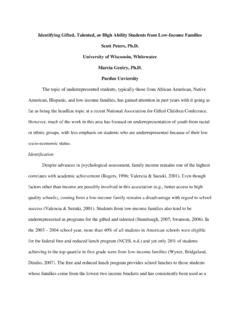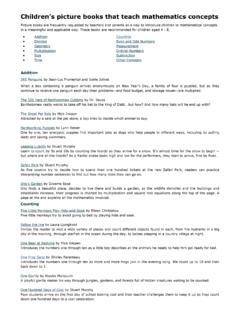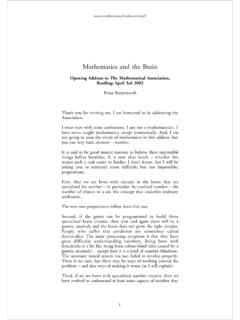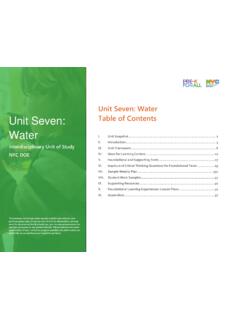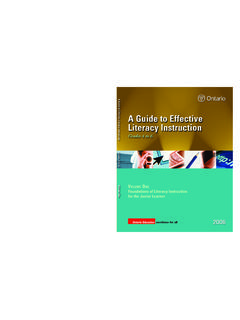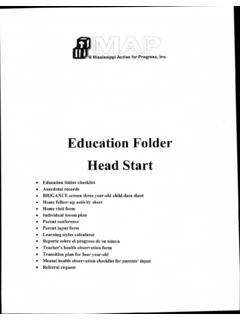Transcription of Eye to eye: connecting with gifted visual-spatial learners
1 Eye to eye: connecting with gifted visual - spatial learners (teaching strategies). Author/s: Rebecca L. Mann Issue: Fall, 2001, gifted Child Today Magazine For his third birthday, Matthew received his first set of LEGO[R] building blocks. While the adults around him happily followed the instructions, Matthew created his own elaborate and unique structures. At 23, after graduating from college, one of the necessities Matthew bought to furnish his first apartment was a large set of LEGO. In the 20 intervening years, Matthew both excelled in and struggled with school. Some researchers suggest that his spatial strengths and sequential weaknesses may be the reason for the extremes in his educational experience.
2 gifted students such as Matthew have been described as having a visual - spatial approach to learning and may present a confusing scenario to teachers and parents (Silverman, 1989, 1997). The disparity between their learning approach and traditional teaching methods may prevent these children's strengths from being identified and nurtured. The United States educational system tends to favor sequential learners ; high-ability children with strengths in the spatial aptitudes and weaknesses in the sequential realm may not be recognized as gifted learners . Successful adults who use this approach to learn tend to have careers in mathematics, science, computer technology, engineering, aeronautics, and the fine arts.
3 Supportive environments, awareness of strengths and weaknesses, and some simple academic modifications may help these children become innovative leaders in society. Strengths of visual - spatial learners Students labeled as visual - spatial learners are frequently adept at puzzles, mazes, reading maps, finding their way in unfamiliar territory, and creating visual images of locations and objects. visual transformations, such as how the furniture in a room would look if it were rearranged, come easily. They can take almost anything apart and put it back together again in working order. Unfortunately, these skills are not valued often in today's educational system.
4 Children who are "LEGO-maniacs" are often visual - spatial learners . Construx[TM], K'nex[TM], and Tinker-Toys[TM] are favorite toys of these children, as are the boxes in which the toys are packaged. visual - spatial learners rarely follow the directions, preferring instead to create their own designs. Computers are another of their chosen pastimes. If a teacher needs to know how to solve a computer technological glitch, ask a visual - spatial child and the situation may quickly be resolved. Many of these children have few toys intact because they are speculators at heart. They have a tendency to pull everything apart to figure out how it works.
5 These learners are reflective and need time to think. As a result, they frequently appear to be off task and day-dreaming. Highly creative, these children often create imaginary playmates who become a part of their lives. Remarkable imaginations find them making up vivid stories that they may have great difficulty putting into written form (Silverman, 1989b). Organization is usually not a strength of this learner. Homework is regularly forgotten, clocks seem to have no meaning, desks look as if they have been ransacked. There appears to be an unwillingness to conform to schedules and routines. Cleaning their rooms may overwhelm these children and seem like an insurmountable task.
6 Sensitive and emotional, these children may call your bluff. They are very good at reading people and sensing ambivalence and anxiety. Also physically sensitive, they may "over-react" to their environment: itchy clothes, unanticipated noise, and visual stimulation. Hypersensitivity also causes these children to be reluctant risk takers (Silverman & Freed, 1991; Sword, 1997). Academically, these learners appear to struggle with easy concepts but thrive on complexity (Baum, 1984). Math computation may be laborious, but abstract math concepts are easy for them to comprehend. Reading aloud may be arduous with little comprehension of content, while reading silently may result in a high level of understanding.
7 These children often arrive at surprising conclusions and keep you guessing what their next response will be. Their struggles with "simple" concepts send conflicting messages to teachers and parents who have listened to their elaborate stories and explanations. Sequential vs. spatial The American educational system is structured sequentially, putting the student with a strong spatial inclination "at odds" with the system. There is a mismatch between the way the child is taught and the way the child processes information. Through her extensive work with highly gifted learners , Silverman (1997) developed a list of characteristics, which contrasts sequential ( , deductive) and spatial ( , inductive) learners (see Table 1).
8 Strategies for Teaching To be successful in school, students with a visual - spatial approach to learning may need to have their strengths recognized and nurtured. "For these people, it is sometimes far easier to learn firsthand from nature than it is to learn secondhand from books," (West, 1997, p. 12). Increasing the level of difficulty, encouraging visualization, teaching holistically, using humor, color, mnemonics, and manipulatives are methods that may be successfully used with these learners . General Strategies " visual - spatial learners need a Gestalt approach to learning. They do best when they deal with whole systems, abstract relationships, major concepts, inductive learning, and problem solving" (Silverman, 1989b, p.)
9 18). They have difficulty attending to details and don't understand if learning opportunities are provided in small chunks. Give these children "the big picture" at the beginning of each unit or activity and explain major concepts so the child understands the instructional goal. With the concept, the frame of the puzzle, in place, the child may then start fitting in the pieces to create a complete picture. Interdisciplinary units are a favorite of these learners who easily make connections between the disciplines. Real-life scenarios and service-oriented projects are excellent opportunities for visual - spatial learners to demonstrate their strengths.
10 "A-ha" describes the way that these learners acquire new information. These children may either totally understand a concept or understand nothing about it. Difficulty explaining the steps of their thinking may be due to their holistic processing. Once the "A-ha" occurs, learning is relatively permanent. Because of this, and the fact that they may not learn by rote memorization, visual - spatial learners detest routine and repetitive tasks (Silverman, 1989c). Allowing opportunities for inductive learning, where the child might discover the content or method, is a highly effective strategy. An effective method that has been used with gifted learners , is to tell them the goal of the instruction and allow them to figure out a way to achieve the goal.
